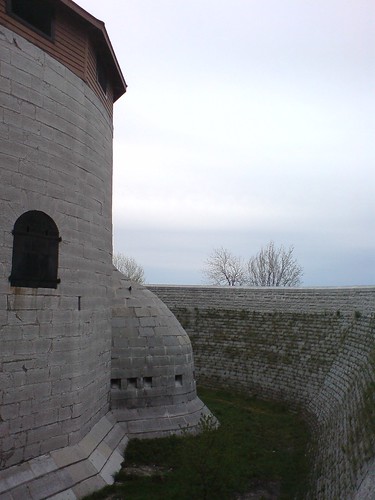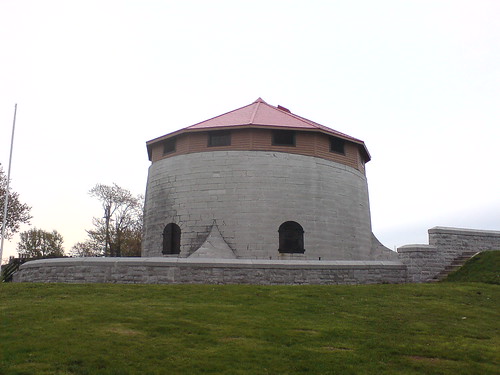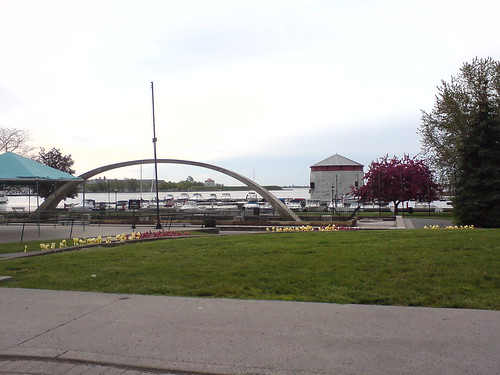
I arrived in Kingston at nine at night — the first stop on my four-and-a-half day sprint from Toronto to Fredericton, New Brunskwick and back for a long weekend. Knowing that I was arriving after dark, and leaving early the next morning, I decided to drop my bags and head out for a late night walk to check out the city.
Staying in a Queen’s University dorm that operates as a hostel during the summer, I set out from the campus. Kingston’s deep history — as Ontario’s oldest city and one of its most influential during the years before Confederation (it was the first capital of the United Provinces of Upper and Lower Canada between 1841 and 1844) — quickly emerged as I found a rolling lawn dotted with old trees stretching in front of a large mansion with a wrap around front porch. Summerhill was built in 1839 by Archdeacon George O’kill Stuart, and was used to house Canada’s first parliamentarians. The property was later purchased by Queen’s College to become the university’s first building, eventually serving as the home of the principal, and has now been converted into administrative offices for the school. I found this adaptive re-use very interesting, because it has enabled the building to survive for almost one hundred and seventy years, providing a beautiful focal and historic point of reference to this part of the campus.

From Summerhill I walked down George St., across King St. to MacDonald Park, which sits on Lake Ontario. The most unique feature of the park is a squat stone tower surrounded by a deep, dry, moat. Known as the Murney Tower, it was built in 1846 by the Imperial Government to protect Kingston from invasion by the United States during the Oregon Crisis. Kingston was a strategically important city because of its position at the intersection of the St. Lawrence River, the Cataraqui River, and lake Ontario, and towers such as this, four of which mark Kingston’s shoreline, were meant to act as a guard against invasion. This type of tower is called a Martello Tower, and is a striking monument to British military interest in Canada during pre-confederation years.
Leaving MacDonald Park I walked along King St., which is boarded on the north side by the Victorian-age City Park, and on the south side by old stone homes. It is this part of my walk where Kingston’s history really enveloped me, as I passed houses with plaques attesting to the historic significance of the figures that once lived here or there, and statues of the city’s historic heroes (like John A. MacDonald). Admittedly romantic, my nostalgia for the era when Kingston boomed as a military and political city wasn’t dampened by the modern towers that I spotted going up just south of King St. along the lake, or the large modern hotel that I eventually come across on King, I don’t know enough about the context in which these buildings were developed, nor do I think it is necessary for an entire city to be preserved as some kind of museum where nothing changes. I just really appreciated the integrity of the historical area that I was walking through.

As I reached the downtown my enthusiasm only heightened as I passed St. George’s Cathedral, (the dome echoes St. Paul’s Cathedral in London), and eventually reached the back of Kingston City Hall, which was built when Kingston was the capital of the United Provinces. Here, a plaza known as Market Square (that looks newly refurbished with outdoor seating and space for live performances — until recently it doubled as a parking lot) has served as an open air market for more than two-hundred years. Walking around City Hall I crossed Ontario Street to Confederation Park, which was opened in 1967 to celebrate Canada’s centennial year. At the centre of the park, is a monument that celebrates the centennial — a minimal concrete arch that straddles a rectangular fountain (representing Canada’s unity from sea to sea).
The park was built over a remediated train yard, an artifact of which is the old K&P Railroad Station, built in 1888 from stones that were salvaged from the demolished Market Battery that originally sat on the site before the rail yard was built. The station now houses a tourist information bureau. From the base of the park is a series of docks where pleasure boats are tied, and in the middle of the docks is another squat stone tower — The Shoal Martello Tower. Rendered harmless by the vessels moored at its base, the tower only faintly echoes its once severe and intimidating presence to ward off invaders from traveling up the Cataraqui River. But aligned with the front doors of the Kingston City hall to the north, across from the sleek arch of the centennial fountain, and anchoring Confederation Park — where plaques re-tell the story of Kingston’s development from a native settlement, to a European trading post, to a boom town for escaping Empire Loyalists — the tower’s presence is invaluable as it adds yet another interesting layer to the rich history of Kingston ‘s venerable downtown.
The next morning, as I quickly drove around to take some pictures that were too difficult to capture in the dark, I looked again across Confederation Park and in the distance, sitting in front of the Royal Military College, I saw another of the Mortello Towers, and for another moment appreciated Kingston’s place in Canada’s history, and how that history is preserved in the city’s architecture.








6 comments
For anyone interested, Kingston’s Doors Open runs Saturday, June 28. It’s a chance to see inside some of these great places.
Dude, you should have gone to Stages.
DR > Although I didn’t go to Stages, I went to the Tir nan Og instead. It was pretty nice – good beer, good atmosphere.
You should have gone to the Toucan; it’s like Tir nan Og with cheaper beer, less light, and no pretension. Plus they’ve got Newcastle on tap.
That’s about all there is to see in Kingston. Seriously, I used to live there, and it’s pretty boring. The rest of the city is nothing but suburbs and strip malls. And buses that run about every hour or so.
Matthew, I am so glad that you enjoyed your visit to Kingston. We (Kingstonians) are so lucky to live in such a beautiful setting. Our history is what makes our city unique. I am so glad that you appreciated it. If you are in Kingston again, especially in the evening you must take part in the Haunted Walk.